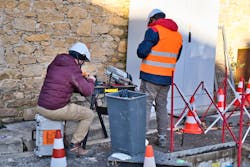Service provider installation tips on the way from 'homes passed' to 'homes connected'
Ed. Note -- The following article excerpt is from a recent technical piece penned by Fiber Broadband Association 2022 board of directors chairman Kevin Morgan, who is also chief marketing officer of Clearfield, Inc., for Lightwave, CI&M's sibling publication in Endeavor Business Media and a longtime chronicler of the optical telecom technology space.
Morgan's central contention in the article is that:
Among the measurements of success investors currently use to gauge the value of broadband service providers is the number of homes passed by their networks. The statistic indicates the potential number of customers within a service area, which is valuable, but does little to indicate the number of households that are essentially “revenue ready.”
"Homes connected" is the emerging benchmark for service provider success, providing a precise number as to the number of households that can quickly generate revenue with little to no capital expense involved – in some cases, by simply pressing the Enter button after signing up for service on a web portal.
This excerpt from the article brings home a range of fiber-optic cabling and connectivity tips from the fiber broadband service provider sphere.
Service providers are going to have to change the way they do installations to become more efficient to move the goalposts from homes passed to homes connected. The work begins by examining the process of making physical connections from the core network to the neighborhood, household, and inside the house.
Time saved in an efficient and quality installation process enables service providers to maximize value out of their available field installation workforce and leads to more installations – more homes connected – per day. The best way to save time is to invest in craft-friendly technologies that are plug-and-play in nature to minimize splicing and other types of touch labor during installation so field teams can be as effective as possible when they are on-site.
Using a craft-friendly broadband deployment technology when connecting fiber to the home has been shown to save anywhere between 35% to 38% in direct time savings when compared to the baseline method of inside and outside work performed.
The key is in leveraging technology in connection products rather than having to do extra work manually, step by step, in the field.
Simplification starts by using a house cable supplied on a flexible deploy reel that contains up to 100 feet of flexible optical cable and by using pre-connectorized cable products for both the drop cable from the outside plant (OSP) network and the house cable that enters the home.
Using a prepped deploy reel for the house cable minimizes pre-engineering because there’s no need to specify an exact length of cable needed. The reel enables optical cable to be pulled directly to the entry point of the house.
Once the entry cable with its pushable connector reaches the location inside, the connector assembly is completed with supplied connector housings and the connector is mated to an adapter. Since the slack on the reel is already stored, no further slack management is required.
This process eliminates the requirement to set up a connector installation station since the cables are pre-connectorized – no fuss, no muss, no splicing or putting on connectors in the field.
The preloaded cable reel eliminates the need to set up a cable payout station to cut house cable to custom length, inserting the cable into the home, and splicing both ends.
Survey shows the benefits
A large service provider recently commissioned a study to quantify the time saved using the method and technology described above when conducting residential installations, using a baseline of 12 steps for outside and inside work.
When compared to a previous baseline study, the craft-friendly broadband deployment method saved between 35% to 38% across outside and inside work during a total of 159 installations.
The baseline study pointed to several potential failure points using field-installed connectors and fiber cables cut and installed on site.
Field-installed connectors had less successful connections, delivered higher optical loss, took more time to install, and required more truck rolls for fixing problems overall.
With cables cut in the field and installed onsite, problems can be introduced by cable stripping, fiber cutting and fiber cleaving in an unprotected environment, creating a cable pay-out rig onsite, and relying on a technician to coil slack storage by hand and then fit the slack into the TAP box.
Utilizing craft-friendly hardware, including pre-connectorized cable products for both the drop cable and the house cable supplied on a deployment reel, minimized pre-engineering for specifying an exact length of cable needed and eliminated the need to install connectors in the field or improvise cable slack management for both inside and outside work. This process eliminated the need to set up a connector installation and cable payout stations onsite.
The study found that craft-friendly technology saved an average of 39 minutes on outside fiber work and 19 minutes on inside work.
